This post may contain affiliate links. Read more at our disclosure policy.
Smoked Beef Tenderloin is absolutely incredible. It combines tender beefy flavor with the richness of smoke. We’re using the reverse sear method for this recipe to create an incredible smoky flavor, then finishing it over a hot grill for that perfect sear, and then slicing it into medallions to serve.
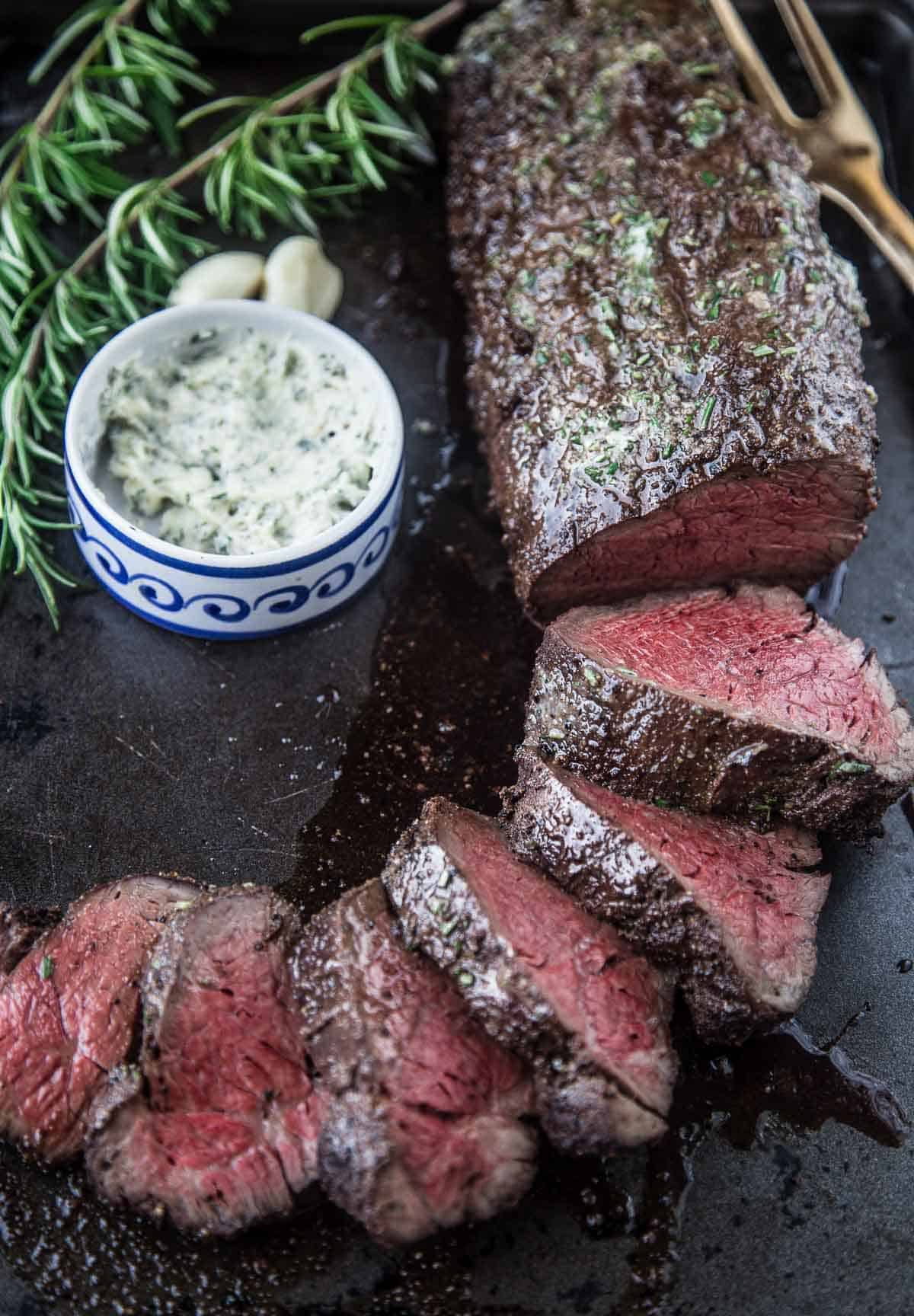
This post is sponsored by Beef. It’s What’s For Dinner. on behalf of the Beef Checkoff. All opinions are my own.
Whether a holiday dinner or special occasion, various cuts of beef create a great options for crowds and can be adapted for use on a grill or smoker. Our smoked Beef Tenderloin is the perfect example. This step by step process follows the reverse sear method to give you the perfect, tender, smoked Beef Tenderloin every time.
Table of Contents
- What is Beef Tenderloin — The Cut
- Buying Beef Tenderloin
- Ingredients + Substitutions
- Tools
- How to Trim Beef Tenderloin
- Preparation + Seasoning
- How To Smoke Beef Tenderloin
- What Internal Temperature Do I Cook Whole Beef Tenderloin To?
- Serving
- Best Sides for Smoked Beef Tenderloin
- What Wine to Pair with Smoked Beef Tenderloin?
- Other Beef Recipes
- Smoked Beef Tenderloin Recipe – Reverse Seared
But first let’s talk about Beef Tenderloin.
What is Beef Tenderloin — The Cut
Beef Tenderloin is a muscle that comes from the rear, or backbone, of the cow beneath the ribs. This location gets little movement as the animal roams, so there is less connective tissue. It’s why this cut is so lean and tender versus one that gets a lot of movement, like chuck roast or beef brisket.
Beef Tenderloin is the most tender beef muscle next to flat iron steak. The flavor profile is rich and buttery when cooked to the right internal temperature.
Buying Beef Tenderloin
It’s an expensive cut. You can buy the tenderloin roast already trimmed, but this will cost you more per pound. We like to buy an untrimmed roast and then cut it into our roast shape, and then use the other scraps and pieces for other dishes. If you buy the entire roast it may come connected with butcher’s twine. We remove the twine while it cooks because smoked tenderloin won’t lose its shape.
The whole tenderloin should be trimmed into three parts.
- The Butt – This larger end is great for steaks or to cook as an entire roast itself.
- The Center Cut – Filet Mignon steaks come from this area. It has a uniform and consistent shape.
- The Tail – Great trimmings to use in stir fry or pan searing with a sauce.
Have questions on various grades of beef? Check out our article on the beef grading system when making a decision on buying beef tenderloin.
Ingredients + Substitutions
You only need a handful of ingredients. It’s the meat that is the star of the show, so we avoid getting too much in the way of that.
- Extra Virgin Olive Oil – Olive oil acts as a binder, which allows the beef seasoning to stick to the meat.
- Trimmed Beef Tenderloin Roast – To save money – buy an entire untrimmed or unpeeled whole tenderloin and then cut it into the roast. The trimmings can be used in other awesome recipes.
- Seasoning – We use a blend of herbs and dried species for a savory, no sugar beef seasoning. Alternatively you can go simple with a kosher salt, black pepper, granulated garlic, or SPG rub.
Tools
Having all the right tools makes the entire cooking process easy.
- Cutting Board – A large cutting board is ideal so you can layout and trim the entire beef tenderloin.
- Filet Knife – We use a good filet knife for trimming and slicing up the roast.
- Long Tongs – Anytime we are using the smoker and grill we like a good sturdy set of long tongs.
- Instant Read Meat Thermometer – The most important tool to own. We always cook to the proper internal temperature, not time.
- Good Lump Charcoal – It adds flavor and heat.
- Wood – We like to smoke with wood chunks in our Big Green Egg or kettle grill, specifically we use apple, cherry, or oak wood.
How to Trim Beef Tenderloin
When buying a whole Beef Tenderloin, you will see either peeled or unpeeled. Unpeeled has the silver skin and surrounding muscle still on it, often referred to as “the chain”. Peeled typically has all of that removed (and much easier for when you trim). Regardless of which you find, you will still need to do some trimming. For our smoked Beef Tenderloin, we are using the center cut.
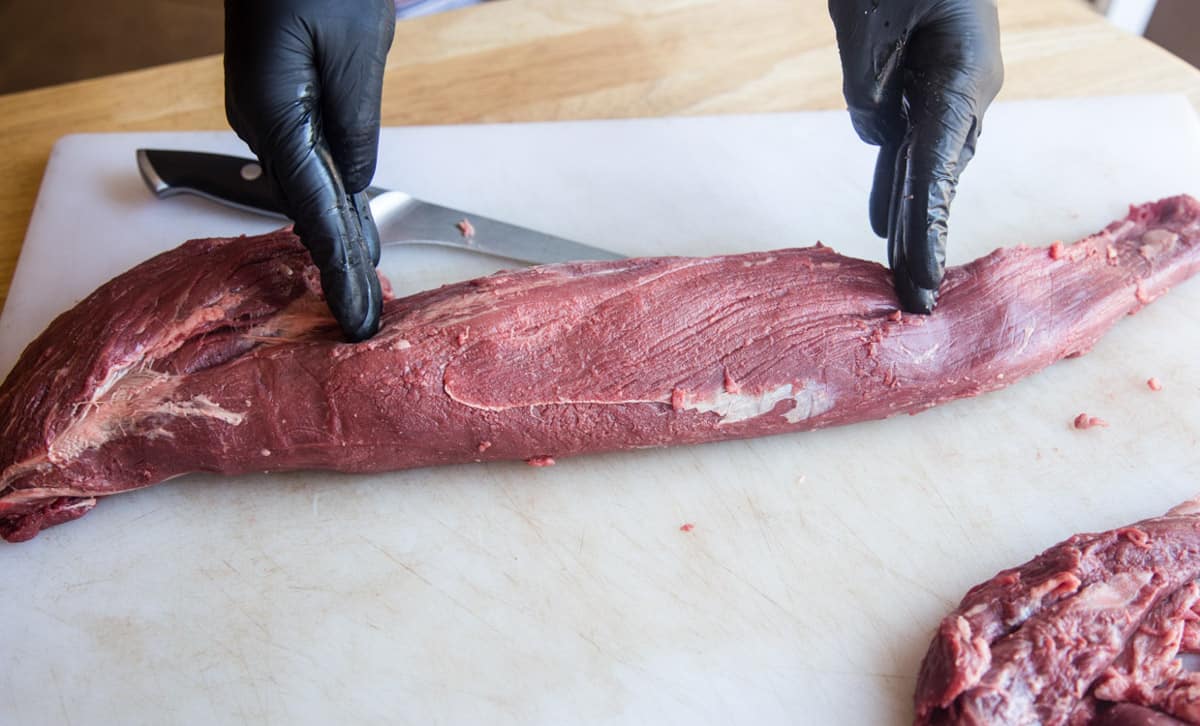
Pro-Tip – Buying large beef cuts, like tenderloin, prime rib, or strip loin is a great way to save money. Just trim and then cut up the steaks, and vacuum freeze until you’re ready to use them.
First, trim off the tail, or the thinner tapered side so the center cut tenderloin is a consistent size. This is important for consistent internal temperature while cooking.
Option – You can tuck the tail back onto the tenderloin and tie it (with butcher’s twine), this method is common when roasting in the oven. For this recipe, cut off the tail and use for a stir fry.
Next, cut off the butt end. There will be a few areas of muscle that are loose or were removed when separating the loin, such as the chain. Bring the knife along the edge of the loin on the butt end and remove the flap meat and then bring a vertical slice to remove butt from the tenderloin for the same consistent size. Save this trim, or butt, for smaller steaks, or to cook for sliced steak sandwiches.
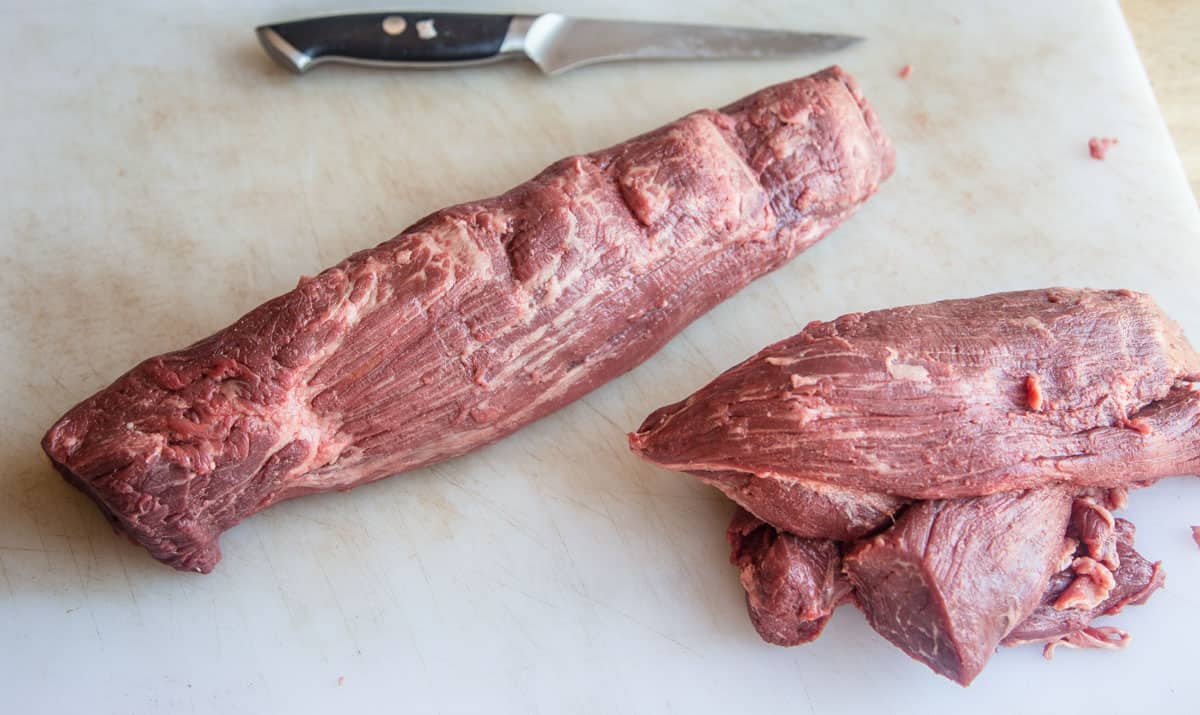
Finally what is left is the center cut Beef Tenderloin. Remove the silver skin and larger pieces of fat. This is the step where you can slice into Filet Mignon from the center cut of beef if you wanted to make individual steaks. Leaving the center cut tenderloin whole (sometimes referred to as the Chateaubriand steak) for the smoker is much easier for smoking and grilling, otherwise known as the reverse searing method.
Looking for a good Filet recipe? Check this one out.
Preparation + Seasoning
Generously apply olive oil to the trimmed roast, then add your beef seasoning. This cut is lean and delicious on its own, so we simply want to compliment the beefy flavor with a simple seasoning.
Myth: There is no reason to let the roast come to room temperature for an hour. The internal temperature will barely change from fridge temperature. Just be sure that your smoker is preheated and ready to go.
How To Smoke Beef Tenderloin
For smoked tenderloin we follow our basic reverse sear method. This incorporates a wood smoke flavor profile first, and then finish with high heat, to get the exterior texture.
Would you like to save this?
- Smoke – Get the temperature of the smoker to 250 degrees F, using apple or cherry wood. Smoke until the internal temperature of the meat reaches 115 degrees F. The Tenderloin is not done yet, we are going to continue cooking over high heat to our desired finishing temperature of 130 degrees F. This should take roughly 45 minutes to an hour.
- Sear – When the beef tenderloin reaches the desired smoke internal temperature of 115 degrees in the thickest part of the tenderloin, remove the meat and add it to a high heat to finish (grill, broiler, or cast iron pan). In this case we removed the meat, then increased the temperature of the grill (getting it nice and hot), then finish it by searing it over the hot grill. Alternatively you can finish it in a searing hot cast-iron pan, if your pan is large enough for your loin. It should take 2-3 minutes per side to get a nice crust.
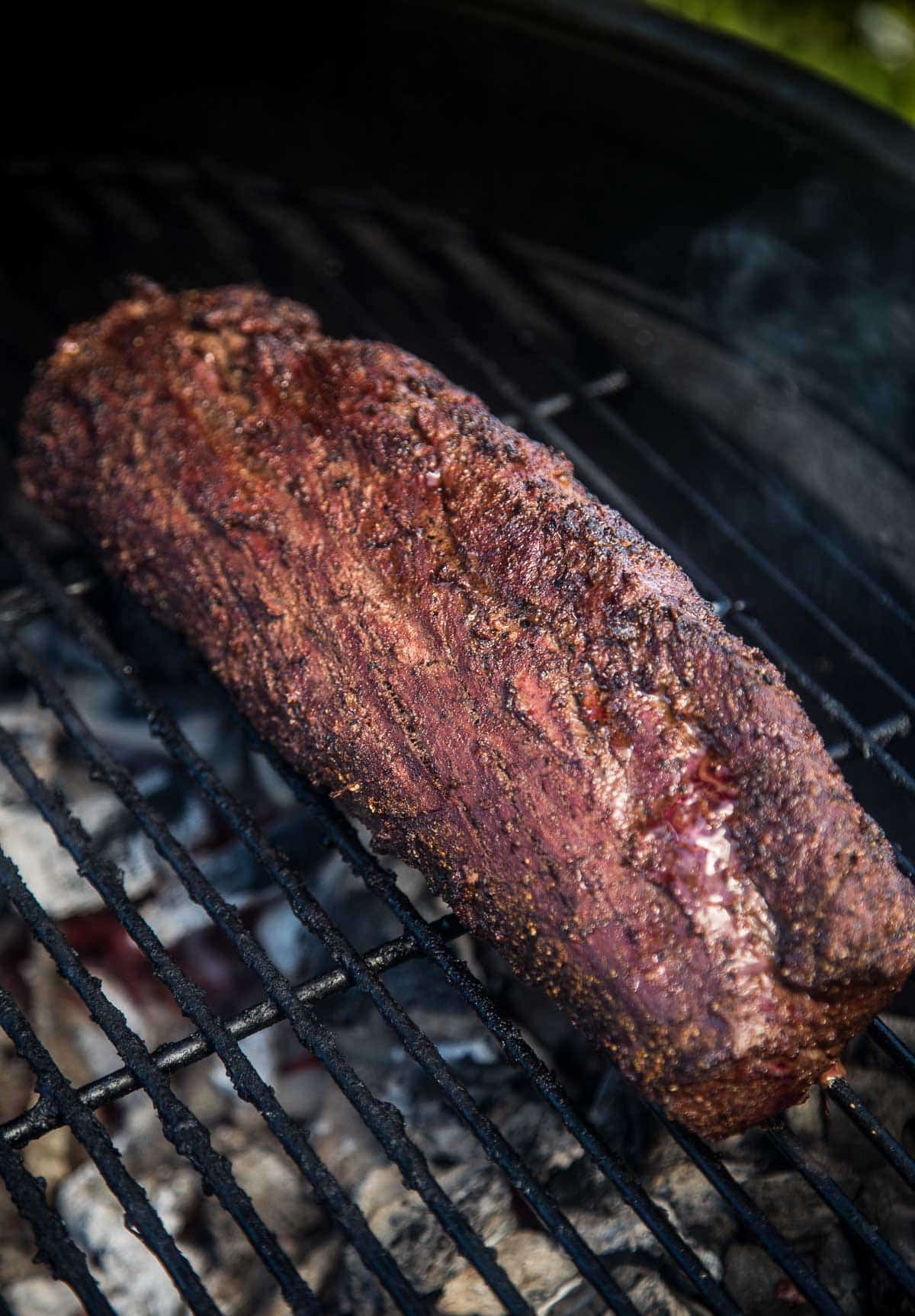
- Rest – A critical step is to remove the meat from the grill at your desired internal temperature, which for us is 125 degrees F, and let the meat rest for 15 minutes. The internal final temperature will rise to 130 – 135 degrees F. The resting period allows carry over cooking to occur.
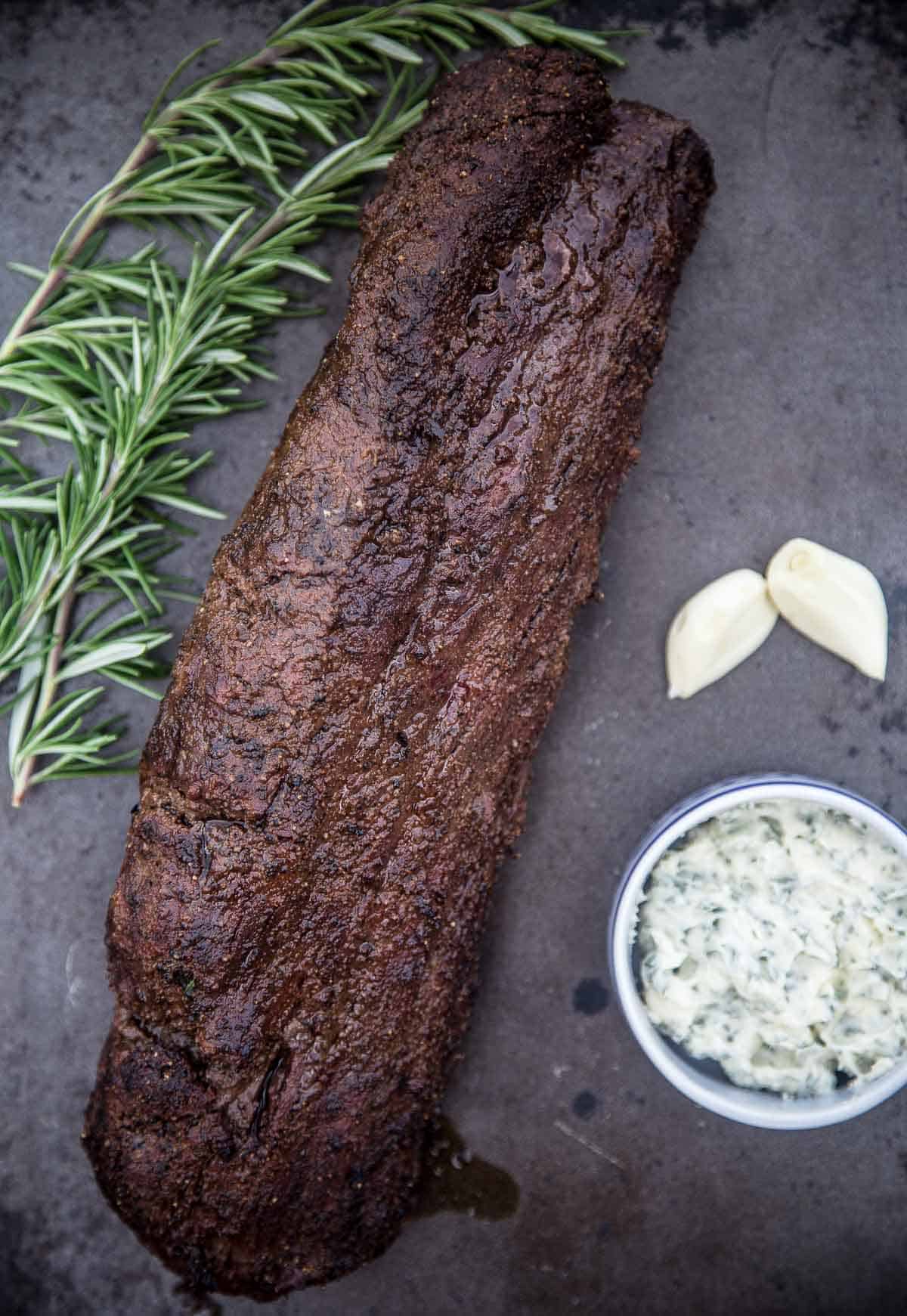
Smoker Tips
Pellet Grill – If using a pellet grill follow the same instructions. Set your pellet grill to 250 degrees and follow the same directions. If you use the smoke feature the ambient temperature will be closer to 180 degrees F in the cooking chamber. It may add more smoke but it will take longer to cook. For searing we like to finish on the stove top in cast iron or under the broiler.
Gas Grill – Use an indirect heat set up with a smoker box. You can adapt this recipe using our guide on how to smoke on a gas grill. When it hits your desired internal temperature after smoking, turn on two burners. Let the grill get to 500 degrees F in the cooking chamber and finish with a sear.
Big Green Egg/Kamado Grill – Place the ConvEGGtor plate over the charcoal and wood chunks after ignited. Place the grill grate on top of the plate. Bring the temp to 225 degrees F and then close vents to fine tune to 250 degrees. When done smoking, remove the grate and plate using heat safe gloves and get the smoker up to 500 degrees to finish with a sear.
What Internal Temperature Do I Cook Whole Beef Tenderloin To?
For this cut and for a crowd we cook the beef tenderloin to rare, or 125 degrees Fahrenheit (it will temp up to 130, see below). Be sure temperature is taken in various areas of the beef tenderloin using a good instant read thermometer.
Pull at 125 degrees F, because of the cooking process called carryover cooking. The internal temperature of the meat will continue to rise another 5 degrees to the target temperature of 130 degrees F as it rests. This avoids overshooting the target temperature.
Beef Temperature Ranges
If you like your roast cooked longer focus on pulling 5 degrees before your target temperature. Be sure when accounting for the below times you plan carry over cooking.
Beef Temperature Ranges
Be sure to take into consideration the carry-over cooking that happens while the steak rests. For steaks remove them 5 degrees lower than your desired temperature. For roasts remove them 10 degrees lower. The steak’s internal temperature will rise as it rests.
| Black and Blue | 100 – 120° Fahrenheit (F) | 37 – 48° Celsius (C) |
| Rare | 120 – 130° F | 48 – 54° C |
| Medium Rare | 130 – 140° F | 54 – 60° C |
| Medium | 140 – 150° F | 60 – 65° C |
| Medium Well (not recommended) | 150 – 160° F | 65 – 71° C |
| Well Done (not recommended) | 160 – 170° F | 71 – 76° C |
Serving
After resting, slice the beef tenderloin in small medallions of 2 to 3 ounces each and serve two to a plate. Now go grab your beef tenderloin, invite your friends over for a great memorable meal, and get smoking!
We love this on its own, but you can also top the slices with your favorite steak sauces. Add a simple compound herb butter as a beautiful finish to the beef tenderloin.
Or add a red wine pan sauce like in our cast iron steak bites.
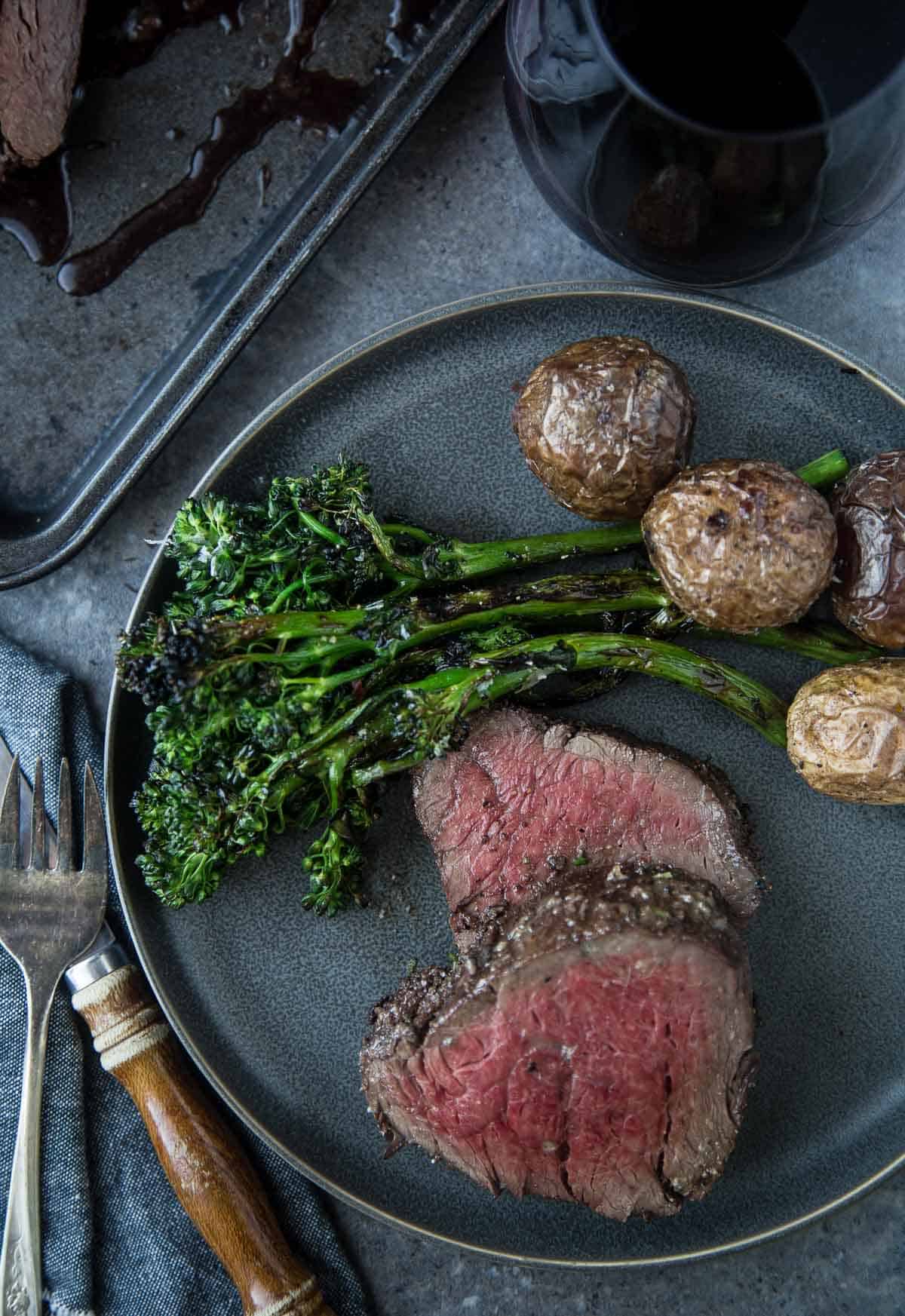
Best Sides for Smoked Beef Tenderloin
Explore all of our side dish recipes, or try it with some of our favorites.
- Grilled Broccolini – This is our first pick. It grills quickly while the tenderloin rests and takes on an amazing smoky flavor. Drizzle with some grilled lemon for even more flavor.
- Roasted Potatoes – These perfectly roasted potatoes have a crispy exterior and soft interior. The secret is par boiling first.
- Collard Greens – A rich sauteed mix of collard greens, smoked turkey, and stock.
- Grilled Carrots – Finished with a maple syrup glaze.
What Wine to Pair with Smoked Beef Tenderloin?
Beef Tenderloin is a lean cut of beef packed with flavor. Which means for wine, a less tannic wine is best like a Merlot from Sonoma or Washington state, or Rhone Valley Syrah. We also have the complete guide to pairing wine with beef roasts.
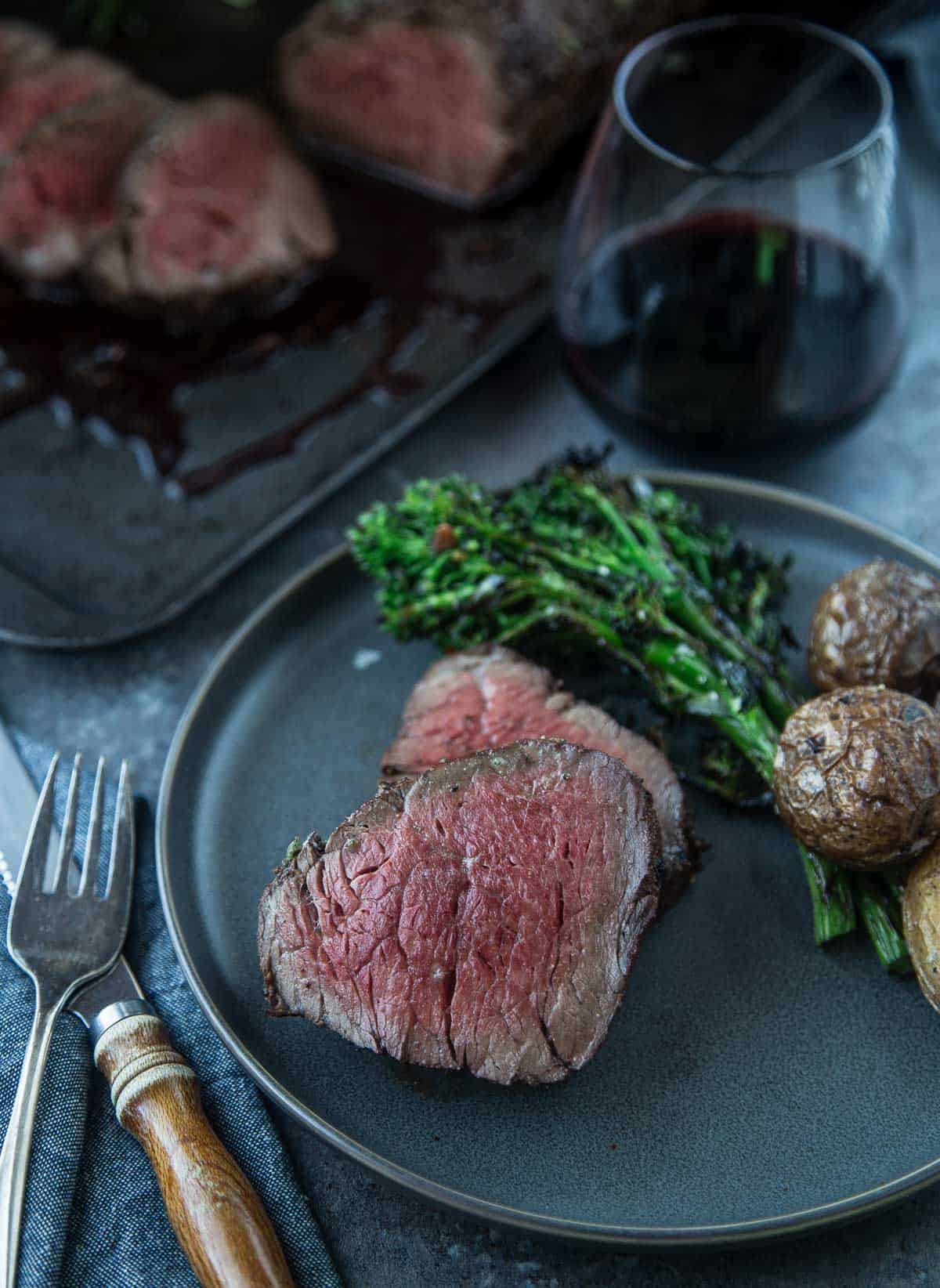
Other Beef Recipes
Check out our full range of beef recipes or explore some of our favorites.
- Smoked Brisket – Our perfectly smoked brisket recipe will leave you wanting more. Conquer the king of all BBQ cuts.
- Grilled Beef Tenderloin – If you are strapped for time you can opt for grilling the tenderloin topped with a decadent mustard steak sauce.
- Reverse Sear Ribeye – If you love ribeye, then you need to smoke and sear it for the most flavorful steak you will ever eat.
- Reverse Sear Ribeye Steak Tacos – Also using reverse seared, these are next level tacos.
About Vindulge
Mary (a certified sommelier and recipe developer) and Sean (backyard pitmaster) are co-authors of the critically acclaimed cookbook, Fire + Wine, and have been creating content for the IACP nominated website Vindulge since 2009. They live in Oregon on a farm just outside Portland.
Tried this recipe? Give us a star rating and we would love to see! Mention @vindulge or use the hashtag #vindulge on all the social media handles. And consider subscribing to our newsletter where we drop all our favorite ideas and inspirations every week.
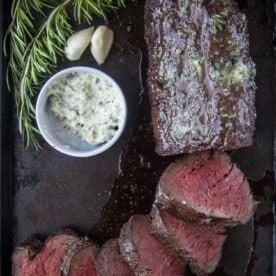
Smoked Beef Tenderloin Recipe – Reverse Seared
Equipment
Ingredients
- 1 3-4 pound center cut Beef Tenderloin, trimmed
- 1 tablespoon extra virgin olive oil
Dry Rub
- ¼ cup beef seasoning
Compound Butter
- 4 tablespoons unsalted butter, room temperature
- 2 peeled garlic cloves, grated
- 1 tablespoon finely diced rosemary
- ¼ teaspoon kosher salt
Instructions
- Trim Beef Tenderloin: Cut off the tail, remove the butt end for a uniform center cut whole tenderloin, save the scraps for other dishes. Remove the silver skin and excess fat.
- Season: Coat the trimmed beef tenderloin with the olive oil, and liberally apply the dry rub to the tenderloin. Cover tenderloin in plastic wrap and store in the refrigerator for 2-3 hours prior to cooking.
- Prep Grill: Remove the tenderloin from the refrigerator and remove from plastic wrap. Prepare your smoker using apple or other fruit wood at 250 degrees Fahrenheit.
- Smoke: Place the tenderloin on the smoker until the internal temperature reaches 115 degrees Fahrenheit. This should take approximately 45 minutes to an hour. Once the temperature of the meat reaches 115 degrees remove tenderloin and set aside for grilling.
- Grill: Prepare grill for high heat or direct grilling. Grill tenderloin 3 minutes per side and remove when the internal temperature of the tenderloin is 125 degrees F (about 8 – 12 minutes total). You will find the tenderloin has roughly three sides as it smokes and makes it easy to rotate.
- Rest: Remove from heat and let rest prior to slicing, this is when carry over cooking will take the internal temperature to 130 degrees F. Prepare compound butter by combining all ingredients in a small bowl. Slice the tenderloin into 2-ounce medallions, and serve two to a dish. Using a spatula add about ½ tablespoon of compound butter to the warm steak where it will melt.
Video
Notes
Nutrition
Nutrition information is automatically calculated, so should only be used as an approximation.
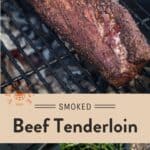
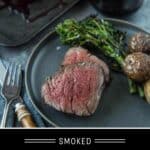
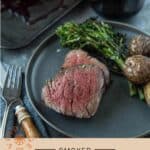
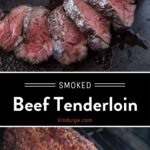
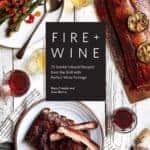

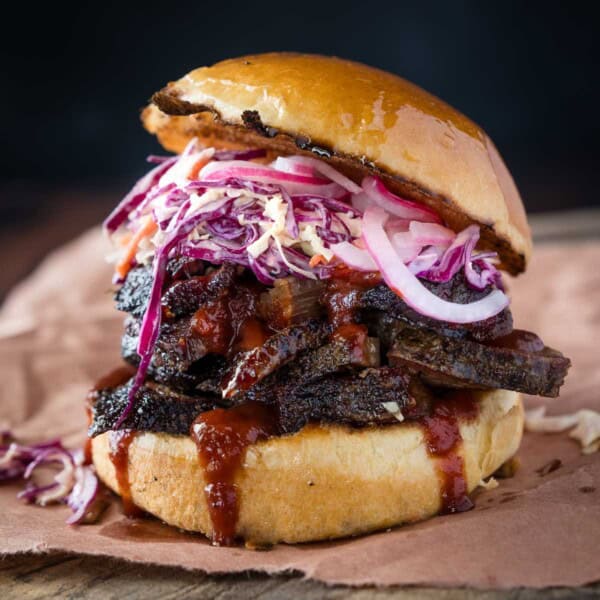
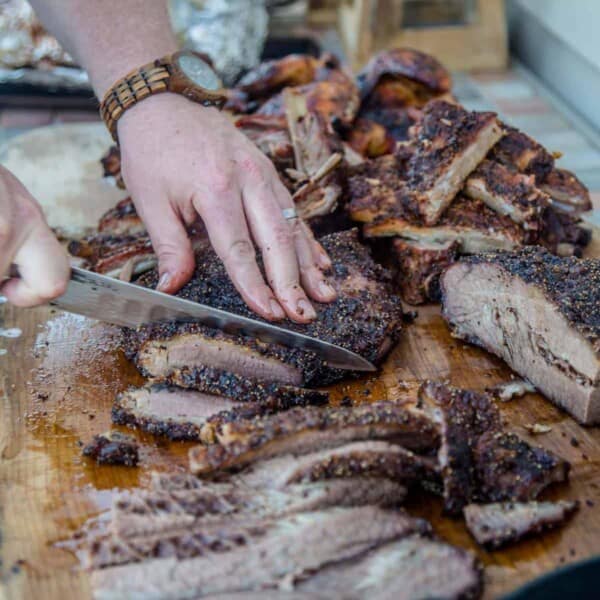
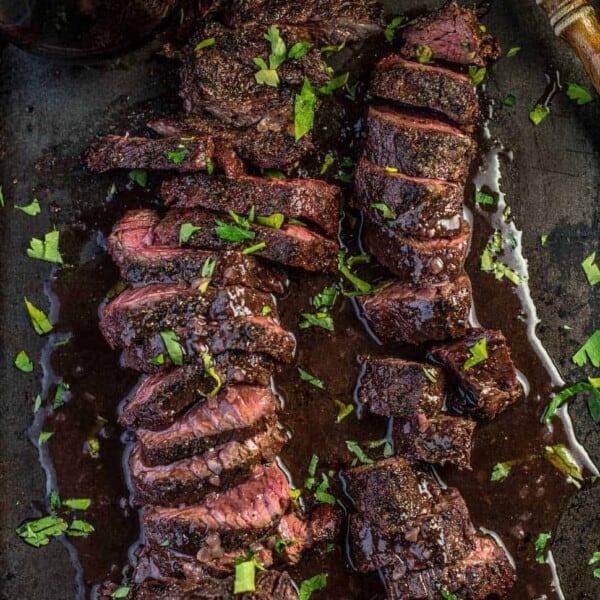
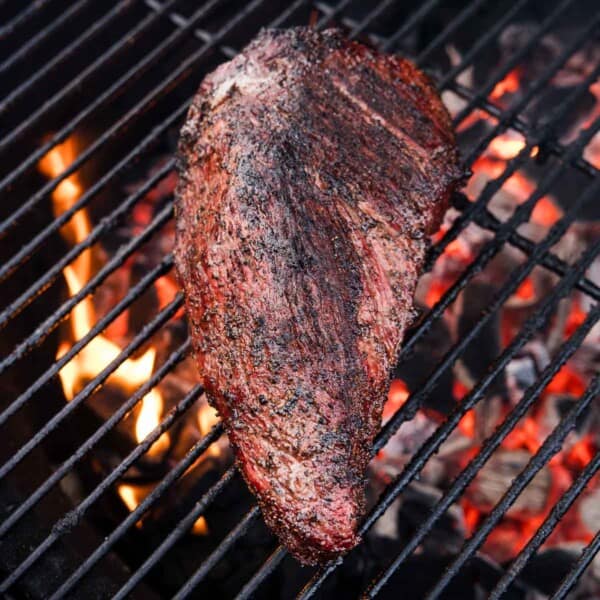
















I strayed only a bit from this excellent technique. I used 3/4 stick of butter, same amount of other ingredients. Mine smoked to 130 within an hour in 250 degree smoker., which was 2 hours sooner than I had thought. Wrapped it in foil and refrigerated. Set on 500 degree Weber to desired charring on 2 sides, it was perfect. I think chilling the meat kept the inside from cooking further on the grill. Definite keeper recipe.
My husband has never been a tenderloin fan. I made your recipe about a month ago and it was delicious. He asked me to make it again! Thanks for the great recipe.
Julie, that is so awesome!!! And thank you for taking time to leave a comment! We hope you keep coming back! 🙂
Yes, I agree with 120 degrees to start sear and go to 125, then let it rest. Respectfully, I really think 145 is medium, not medium rare.
Great point. Chef temperatures range across the board on what would constitute medium versus medium rare. We collaborated with Beef! It’s What’s For Dinner! on this content and elected together on 145 for medium rare. And that color in the tenderloin is at 145. But we encourage anyone to cook to their preferred temperature based on their preference.
We prefer medium rare, and start reverse sear about 120°, and remove from grill at 125° to let stand, for a very nice medium rare.
Oh Wow! I’ve never smoked a tenderloin so was nervous that I’d mess up such a pricey cut of meat. I mean, anybody can smoke a pork shoulder. Well, I must say I’ve never been more impressed with a tenderloin. This recipe is easy to follow and I did follow it exactly (using applewood on a komodo at 225). At the table, I had to stop myself from over-eating, all my kids enjoyed it, and my teenage daughter who rarely eats meat was clamoring for more. This is very good and worth a try. I’ll be repeating for sure. thanks!
Bryan awesome!!! Thanks so much for sharing your feedback!
Making this today. By covered do you mean close the lid or did you cover with foil?
Yes, covered specifically means closing the lid.
This post has made my mouth water. I do love a Northern Rhone Syrah but would also love this with a nice Chateauneuf du pape!
Oh that sounds amazing!!!! Let us know when you find one and we’ll pop on over!! 🙂
I’ve never heard of the reverse sear method before, but I totally believe you! You’re the grilling experts!!
Thanks for the detailed step by step starting from even knowing what it is and how to cut it – all the photos are super helpful to help visualize the explanation
This looks like the perfect dish for an elegant dinner party at home! I’ll for sure have to give the reverse sear technique a try!